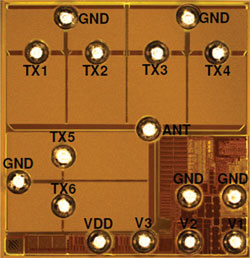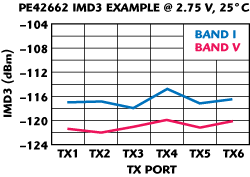
The increasing content of today's smartphones dictates shrinking form factors and increased flexibility in the RF Front-End (RFFE). Mainstream cellular devices support two bands of W-CDMA for home network data access and four bands of GSM/GPRS/EDGE for worldwide mobility. Focus on cost has driven the industry to reuse the W-CDMA duplexers for reception of two of the GSM RX bands to eliminate the two SAW filters, requiring an SP6T switch to manage RFFE signal routing (see Figure 1). Due to the higher loss of W-CDMA duplexers versus dedicated GSM RX filters, additional pressure is placed on achieving low insertion loss in the RFFE switch.

Figure 1 SP6T switch configuration in RF front-end.
A multitude of chipset I/O arrangements and handset form factors create product development difficulties for the RFFE components industry due to the wide diversity of configurations. A common platform that can support "any mode, any band" on all paths has to date been difficult to achieve due to stringent requirements of the RFFE switch such as isolation of 35 dB between paths and IIP3 of > +65 dBm (see Figure 2). This has also served as a barrier to higher levels of integration with the RX and duplexing filters for realizing the most compact and streamlined RFFE solution for handset designers.

Figure 2 Isolation between paths of PE42662 SP6T switch.
The industry's first fully symmetric 3G single pole six throw (SP6T) RF switch, the PE42662 from Peregrine Semiconductor, is the latest release in Peregrine's UltraCMOS™ silicon-on-sapphire (SOS) mobile wireless switch portfolio to address these needs. Built on the STeP3 UltraCMOS process, the PE42662 delivers design flexibility to manufacturers of 3G front-end modules used in multi-band GSM/EDGE/W-CDMA handsets. The switch incorporates six fully symmetric transmit ports that, for the first time, allow designers to develop cleaner layouts with a common universal die, and freely configure any combination of transmit/receive ports for GSM, EDGE and W-CDMA. This new capability makes it easier to design for the multiple modules and 3G handset variations required without compromising increased feature integration, ruggedness and high performance. The new device is available in flip-chip form, which enables single-pass module assembly with CSP filters for reduced manufacturing costs.

Figure 3 IMD3 performance of PE42662.
The 50-ohm switch features Peregrine's HaRP™ technology enhancements to deliver high linearity and harmonic performance of better than 2fo = -40 dBm and 3fo = -40 dBm with +35 dBm applied at 900 MHz (see Figure 3). The PE42662 switch surpasses the market requirement with an IIP3 of > +68 dBm at Band I, II, V and VIII; low transmit insertion loss of 0.5 dB at 900 MHz, 0.6 dB at 1900 MHz; and very high isolation of 38 dB at 900 MHz, 33 dB at 1900 MHz. The switch handles maximum +35 dBm input power into any load condition with ESD tolerance of 4000 V HBM at the ANT port, and 2000 V HBM on all ports.
Additional features of the PE42662 switch include an on-chip CMOS decode logic that facilitates three-pin low voltage CMOS control and low-power standby state, as well as on-chip SAW filter over-voltage protection devices. As with all SOS-based UltraCMOS RFICs, no blocking capacitors are required. The PE42662 SP6T switch offers many advantages to the designer for performance and flexibility in the design of RFFEs.
Peregrine Semiconductor Corp.,
San Diego, CA
(858) 731-9400,
www.psemi.com
RS No. 304
